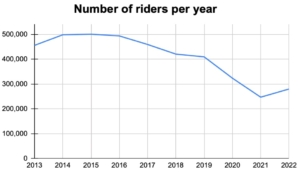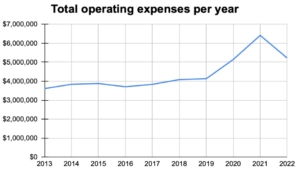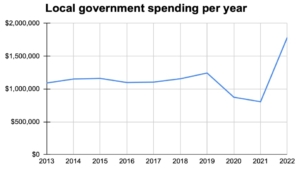Editor’s note: To avoid social repercussions in a small community, the subject of this story requested that only her first name be used and that her son’s name not be used. We granted the request.
Christine M. spent three years trying to find the right learning environment for her son. When he started at Stevens High School in Claremont, the city’s public high school, it was a bad fit.
“We really struggled with that kind of environment for him,” Christine recalled. “He was having a lot of issues going to school, wanting to go to school, getting in engaged in school, not getting in trouble in school, that sort of thing. Getting pretty much nowhere with academics.”
It didn’t help that Stevens High School is not a high-performing academic setting. The school finishes in the bottom 25% in English language arts and math proficiency, at 38% and 26%, respectively.
“Then we went into our sophomore year. Had many, many more struggles. He was being asked to leave all the time for behavior issues. He just couldn’t engage in the classroom…. Our next step this year was to enroll him in the new charter school that opened in Claremont, River View Public Charter School. We enrolled him in that. He was kind of doing okay for a while, and then it became very clear that that method of online learning was not for him.”
River View is a tuition-free public charter school that uses Edmentum, an online learning platform that allows each student to work at their own pace. This wasn’t the right fit for Christine’s son either.
“And we were getting nowhere with that, so we took him out of there,” she said. “And currently I have him homeschooling, and he’s working on studying and preparing for his GED test, his HiSET test. That’s the route we’re doing now.”
After three years and three different learning environments, Christine thought she had finally found the educational setting in which her almost 17-year-old son would thrive. Throughout her son’s high school journey, Christine has had only one goal.
“Try to exhaust all the possibilities to get him successful so that he could a) learn something and b) end up with a diploma at the end,” she said.
Exhausting all the possibilities finally led to the perfect fit, she thought. Christine found Micah Studios, co-founded by Stacey Hammerlind, a former colleague from the Newport School District. (We documented Hammerlind’s story last September.)
“When I heard she was opening this center for homeschoolers, I thought, okay, finally, this may be an option that will be successful, because we had pretty much…exhausted everything else that I could think of. And, of course, now he’s a junior, so we were running out of time, basically.”
When Christine discovered that Hammerlind’s learning center, with its emphasis on individualized education and support, was up and running, she immediately reached out.
“I contacted her when I started seeing that her studio…was taking applications,” Christine said. “So I kind of reached out and was like, ‘I think this might be something that could benefit my son. Can we talk about it?’ And she explained how it worked and all that, and I thought, okay, finally, he could be a homeschooler but have a place to go to do his homeschooling, because my husband and I both work full-time, and I knew that leaving him alone at home was not going to be successful. He wasn’t going to do it; he wasn’t going to do the work. And so that’s when we started talking about tuition, and I quickly found out that there was no way that we could afford it.”
Though they couldn’t pay out of pocket for their son’s education, Christine and her husband learned that enrollment at Micah Studios could be fully funded through an Education Freedom Account (EFA), the state’s largest school choice program. They were very excited.
Micah Studios was just what they’d sought.
“That was what we thought would be the best fit for him after exhausting all the other options, basically,” Christine said.
The environment at Micah Studios fit her son’s individual needs in ways that the public options in the area did not.
“In the past, a lot of the issues were behavioral,” she said. “I know he would work much better in a smaller group with one-on-one instruction versus a classroom, and that’s just something, of course, that couldn’t happen at high school, at Stevens. And the River View Charter it could happen more, but there the kids were kind of just given the format and told to go, and he really needs more direction than that.
“So I think that that would have been a benefit. I know Stacey’s group is small. I think there would have been more time for one-on-one instruction, one-on-one help with his online learning, with his homeschool work. Not to mention, just the distractions of everyday high school life. I mean, he’s a very social kid—class clown, that sort of thing—and that was hampering his success, to say the least.”
Christine had spent three years trying to find the best fit for her son’s education. When she finally found Micah Studios, she thought it was the long-lost answer. Instead, it was the rules of the EFA program—the very entity designed to help families like Christine’s access alternative education programs—that kept their son out.
Christine’s family is not eligible for an EFA.
“When I heard about this thing Stacey was doing,” Christine said, “I thought, oh my God, finally, this is going to be success for him, but then the money got in the way.”
Current law caps eligibility for the EFA program at 350% of the federal poverty level. That makes the maximum income for a family of three like Christine’s $90,370. Her family is just above the limit.
Christine works a full-time job and her husband works two jobs, one full-time and one part-time.
“That’s what we need to do to survive daily,” she said.
Their combined household income is $105,000—too much for their son to qualify for an EFA.
If Christine’s family had another child, both children would be eligible for EFAs. The program’s eligibility requirements are tied to federal poverty guidelines, which are tied to family size. But with one son and three jobs, their family was just over the limit. Now they struggle to homeschool their only child, calculating that this is a better option than sending him back to the two public schools that didn’t work for him.
“Yeah, it’s been stressful,” Christine said. “Luckily my mom, his grandmother, sits with him sometimes and tries to steer him in the right direction, so some work is getting done just not the quantity of work I think if he had been in a place like Stacey’s studio. She’s doing her best to help us out with this, but it’s a burden.”
Asked if she would describe her three-job family as rich, Christine responded emphatically.
“Yeah, no. I would definitely not,” she said. “We’re definitely not a rich family…. We are a family doing our best to get our son educated in not really the most ideal settings for him.”
An Education Freedom Account would mean a lot to her family, Christine said.
“What would it mean to us? I think it would mean that we would not be as stressed all the time. This has been a stress trying to figure out what to do with our son, like how to get him where he needs to go between freshman year and age 18. It would have been a relief for sure. This has been incredibly stressful. We’ve had many, many emotional moments on this journey of high school with him.”
Expanding EFA eligibility from 350% to 500% of the federal poverty level would raise the income threshold for a three-person family from $90,370 to $129,100. This would make Christine’s family eligible.
The same can’t be said about expanding eligibility to 400% of the federal poverty level, which would increase the income cap to $103,280. At that threshold, Christine’s family would still fall short.
A cutoff at 500% of the federal poverty level would still exclude a lot of families, but it would cover more than 60% of school-age children in the state. Though universal eligibility is preferable, this increase would allow many more children to find the educational environments that fit their needs.
“I think being able to qualify for some kind of program like that would have just taken so many stresses out of his high school life,” Christine said, “and I think that it would have made him feel successful at something because I don’t think he feels that way.”
For now, Christine will continue trying to homeschool her son while she and her husband work three jobs to make ends meet. She said that it’s hard, but it’s better than sending him back to the schools that didn’t work for him.














